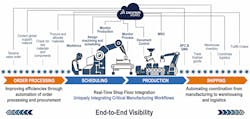Supply Chain and Warehouse Technologies Address Present and Future Disruptions
Beyond the well-known COVID effects on the supply chain, Srini Rajagopal, vice president, logistics product strategy at Oracle, sees several other challenges that manufacturers need to figure into their supply chain strategies, such as train derailments, avian flu and extreme weather incidents.
To these concerns, Ganesh Wadawadigi, chief solution owner, digital logistics solutions at SAP, adds the war in Ukraine, global shortages of computer chips, labor shortages, inflation and rising interest rates as additional supply chain challenges.
“Companies have also seen a surge in consumer demand from the rise of e-commerce and omni-channel fulfillment, requiring them to address the resulting challenges in supply chain planning and execution,” says Wadawadigi.
And then there is the increased focus on sustainability. “Consumers, shareholders and regulators are demanding transparency and accountability from companies when it comes to their supply chain operations, requiring them to demonstrate their environmental, social and governance (ESG) performance,” Wadawadigi says.
Like the supply chains they interface with, warehouse management systems (WMS) can be simple or complex. A simple WMS may only provide inventory and object/personnel location, whereas a more complex WMS system may provide advanced analysis features such as tracking of all labor flows, generating relevant data and exchanging data with remote systems.
According to Louis Columbus, senior manager of DelmiaWorks industry marketing at Dassault Systèmes, “The warehouse management system has earned its place as the go-to enterprise software for managing warehouse inventory and operations, tracking goods, optimizing space utilization and automating a variety of tasks.”
Challenges expected to accelerate
Columbus believes supply chains are in for a wild ride over the long-term. He cites geopolitical conflicts, trade wars, cybersecurity and climate change as the biggest future disruptors to manufacturing supply chains. Other major disruptions come via tariffs and import/export restrictions.
In the last 40 years, supply chain swings have increasingly become more drastic, unpredictable and chaotic,” he says, “and it is nearly impossible to adapt quickly if manufacturers rely on time-consuming, error-prone manual processes.”
He notes that manufacturers can overcome these challenges by “diversifying sourcing and manufacturing locations, creating procurement contract flexibility and maintaining strong supplier relationships. This is why they need to embrace automation, particularly through robotics, manufacturing execution systems, and enterprise resource planning software.”
“Companies need to prepare for an aging workforce, tight labor markets, extreme weather and natural disasters and geopolitical instabilities, all of which ripple through the entire supply chain,” says Wadawadigi. He also agrees AI and automation can help manufacturers better handle disruptions. “AI can help companies gain insights to make informed decisions. Some examples are monitoring supplier performance and getting recommended suggestions, understanding the flow of inventory with effective replenishment strategies, monitoring bottlenecks on transportation routes and optimizing transportation plans based on cost, service level and greenhouse gas emissions.”
In terms of best practices, Wadawadigi notes that some companies are beginning to view logistics as a differentiator rather than a cost center. They are establishing their own logistics center of excellence by combining transport management systems, WMS and logistics-visibility applications to serve their needs and provide external services.
Wadawadigi adds that he sees the use of robots and automated guided vehicles on the rise. “Vendors like Locus and Greek+ are partnering with SAP to integrate their autonomous mobile robots (AMRs) with SAP Extended Warehouse Management to improve productivity and picking accuracy,” he says.
“Some of the most valuable uses of a WMS are in managing inventory and fulfillment with real-time inventory tracking, slotting optimization, and order picking optimization,” adds Columbus. “Real-time inventory tracking reduces stockouts and improves order fulfillment by revealing demand patterns. Walmart and Coca-Cola all track inventory with their WMS.”
Columbus contends that slotting optimization improves inventory handling, space utilization and throughput by showing product dimensions, inventory velocity, and storage requirements. Order picking optimization can also reduce picking errors while improving order accuracy and fulfillment times. Both Nike and Target rely on their WMS software to optimize order picking, according to Columbus.
Vertical industry implementation
When it comes to implementing WMS technology, considerations vary depending on the type of warehouse and/or industry in which the technology is used.
“There are unique challenges for each industry,” Rajagopal explains. “For example, fresh produce and temperature-sensitive products require continuous monitoring through each hand off—from the grower to processing, packing and shipping.”
Columbus concurs that, to be truly effective, a WMS must match the unique challenges the manufacturing user faces. For example, “In the automotive industry, a WMS must support complex assembly processes, just-in-time production methodologies and compliance with industry-specific standards such as IATF 16949 (a technical specification for quality management systems used in the supply chain). The solution also must provide efficient inventory management, allow for the tracking of serialized or lot-controlled items and provide advanced reporting capabilities for continuous process improvement.”
Wadawadigi notes process industries typically require the ability to deal with bulk products that have specific storage and handling requirements.
Changes in WMS
Today, typical WMS technologies include bar code scanning, radio frequency identification (RFID) and various types of automated material-handling systems.
“Among the emerging technologies, arguably the most important is the IoT,” says Columbus, “where the WMS and enterprise resource planning (ERP) software capture real-time data from smart devices and sensors to monitor and track real-time inventory levels, warehouse conditions, and equipment performance. This facilitates data-driven decision making and warehouse optimization.”
He also sees blockchain technology providing a new level of transparency across supply chains to strengthen security.
The impact of new technologies
The top technology advances impacting supply chain and WMS today are artificial intelligence (AI) and its machine learning (ML) subset, internet of things (IoT) connectivity, robotics and cybersecurity.
Rajagopal says these technologies are creating more intelligent and adaptable supply chain processes. For example, Oracle’s Transportation Management platform uses ML to deliver estimated time of arrival predictions based on a customer’s unique business operations.
He adds that Oracle’s Supply Chain Planning application employs AI to generate lead time estimates. This embedded AI feature identifies lead time trends and anomalies, and their potential impact with prioritized actions and resolution suggestions.
For supply chain leaders looking to make their supply chains more resilient and hedge risk via collaboration and information sharing across multi-tier networks, Wadawadigi believes, “These companies need to embark on a digital transformation journey. This means embracing technologies like IoT, smart sensing, digital twins, blockchain AI, robotics, augmented reality, speech recognition, computer vision, data science and cloud computing.”
As examples of this, Wadawadigi cites four application examples:
- New Zealand dairy cooperative Fonterra Co-operative Group’s use of voice-picking—a hands- and eyes-free system based on voice recognition software—to handle large volumes of case picks.
- LED lighting company Hasco Vision’s deployment of 100+ autonomous robots to handle more than 3,000 logistics assignments.
- Smart Press Shop, a joint venture between Porsche and Schuler to produce autobody parts, has moved to paperless production operations using cloud-based operation software and maintains detailed component tracking using digital twins and AI.
- Bechtle is a European IT service provider that offers direct sales of IT equipment and software through e-commerce companies in 14 countries. According to Wadawadigi, the company has been expanding through the COVID-19 pandemic and, to keep their deliveries on time, has automated significant portions of its logistics operations with robots. Using SAP Warehouse Robotics in the cloud, Wadawadigi says Bechtle integrated its first robot installation to SAP Extended Warehouse Management in four weeks. Guided by 3D laser scanners, the robots work autonomously and operate side-by-side with humans, enabling Bechtle to scale production to meet demand by adding additional robots on the fly. With SAP Extended Warehouse Management, Bechtle has the option to source different types of robots from various manufacturers.




